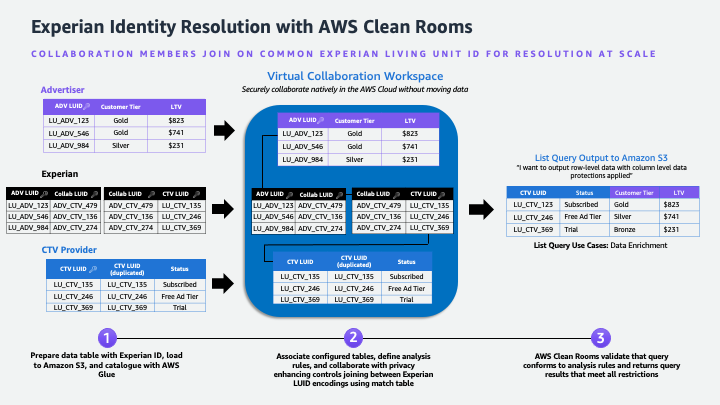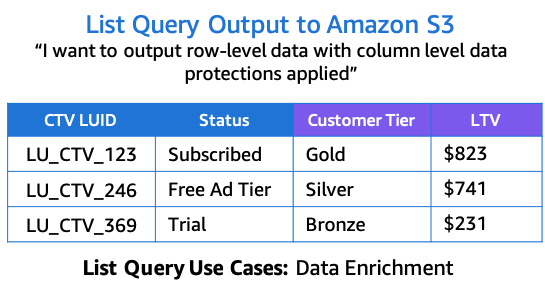AWS Big Data Blog
Using Experian identity resolution with AWS Clean Rooms to achieve higher audience activation match rates
This is a guest post co-written with Tyler Middleton, Experian Senior Partner Marketing Manager, and Jay Rakhe, Experian Group Product Manager.
As the data privacy landscape continues to evolve, companies are increasingly seeking ways to collect and manage data while protecting privacy and intellectual property. First party data is more important than ever for companies to understand their customers and improve how they interact with them, such as in digital advertising across channels. Companies are challenged with having a complete view of their customers as they engage with them across different channels and devices, in addition to other third parties that could complement their data to generate rich insights about their customers. This has driven companies to build identity graph solutions or use well-known identity resolution from providers such as Experian. It has also driven companies to grow their first-party consumer-consented data and collaborate with other companies and partners to create better-informed advertising campaigns.
AWS Clean Rooms allows companies to collaborate securely with their partners on their collective datasets without sharing or copying one another’s underlying data. Combining Experian’s identity resolution with AWS Clean Rooms can help you achieve higher match rates with your partners on your collective datasets when you run an AWS Clean Rooms collaboration. You can achieve higher match rates by using Experian’s diverse offline and digital ID database.
In this post, we walk through an example of a retail advertiser collaborating with a connected television (CTV) provider, facilitated by AWS Clean Rooms and Experian. AWS Clean Rooms facilitates a secure collaboration for an audience activation use case.
Use case overview
Retail advertisers recognize the growing consumer behaviors to use streaming TV services over traditional TV channels. Because of this, you may want to use your customer tiering and past purchase history datasets to target your audience in CTV.
The following example advertiser dataset includes the audience to be targeted on the CTV platform.
|
Advertiser ID |
First | Last | Address | City | State | Zip | Customer Tier | LTV | Last Purchase Date |
| 123 | Tyler | Smith | 4128 Et Street | Franklin | OK | 82736 | Gold | $823 | 8/1/21 |
| 456 | Karleigh | Jones | 2588 Nibh Street | Clinton | RI | 38947 | Gold | $741 | 2/2/22 |
| 984 | Alex | Brown | 6556 Tincidunt Avenue | Madison | WI | 10975 | Silver | $231 | 1/17/22 |
The following sample CTV provider dataset has email addresses and subscription status.
| Email Address | Status |
| tyler_s@gmail.com | Subscribed |
| kjones@yahoo.com | Free Ad Tier |
| alex.bown@outlook.com | Trial |
Experian performs identity resolution on each dataset by matching against Experian’s attributes on 250 million consumers and 126 million households. Experian assigns a unique and synthetic Experian ID referred to as a Living Unit ID (LUID) to each matched record.
The Experian LUIDs for an advertiser and CTV provider are unique per consumer record. For example, LU_ADV_123 in the advertiser table corresponds to LU_CTV_135 in the CTV table. To allow the CTV provider and advertiser to match identities across the datasets, Experian generates a collaboration LUID, as shown in the following figure. This allows a double-blind join to be performed against both tables in AWS Clean Rooms.

The following figure illustrates the workflow in our example AWS Clean Rooms collaboration.

We walk you through the following high-level steps:
- Prepare the data tables with Experian IDs, load the data to Amazon Simple Storage Service (Amazon S3), and catalog the data with AWS Glue.
- Associate the configured tables, define the analysis rules, and collaborate with privacy-enhancing controls joining between the Experian LUID encodings using the match table.
- Use AWS Clean Rooms to validate that the query conforms to the analysis rules and returns query results that meet all restrictions.
Prepare data tables with Experian IDs, load data to Amazon S3, and catalog data with AWS Glue
First, the advertiser and CTV provider engage with Experian directly to assign Experian LUIDs to their consumer records. During this process, both parties provide identity components to Experian as an input. Experian processes their input data and returns an Experian LUID when a matched identity is found. New and existing Experian customers can start this process by reaching out to Experian Marketing Services.
After the tables are prepared with Experian LUIDs, the advertiser, CTV provider, and Experian join an AWS Clean Rooms collaboration. A collaboration is a secure logical boundary in AWS Clean Rooms in which members perform SQL queries on configured tables. Any participant can create an AWS Clean Rooms collaboration. In this example, the CTV provider has created a collaboration in AWS Clean Rooms and invited the advertiser and Experian to join and contribute data, without sharing their underlying data with each other. The advertiser and Experian will log in to each of their respective AWS accounts and join the collaboration as a member.
The next step is to upload and catalog the data to be queried in AWS Clean Rooms. Each collaborator will upload their dataset to Amazon S3 object storage in their respective accounts. Next, the data is cataloged in the AWS Glue Data Catalog.
Associate the configured tables, define analysis rules, and collaborate with privacy enhancing controls
After the table is cataloged in the AWS Glue Data Catalog, it can be associated with an AWS Clean Rooms configured table. A configured table defines which columns can be used in the collaboration and contains an analysis rule that determines how the data can be queried.
In this step, Experian adds two configured tables that include the collaboration LUIDs that allow the CTV provider and advertiser to match across their datasets.
The advertiser has defined a list analysis rule that allows the CTV provider to run queries that return a row-level list of the collective data. They have also configured their unique Experian advertiser LUIDs as the join keys. In AWS Clean Rooms, join key columns can be used to join datasets, but the values can’t be returned in the result.
Use AWS Clean Rooms to validate the query matches the analysis rule type, expected query structure, and columns and tables defined in the analysis rule
The CTV provider can now perform a SQL query against the datasets using the AWS Clean Rooms console or the AWS Clean Rooms StartProtectedQuery API.
The following sample list query returns the customer tier and LTV (lifetime value) for matched CTV identities:
The following figure illustrates the results.

Conclusion
In this post, we showed how a retail advertiser can enrich their data with CTV provider data using Experian in an AWS Clean Rooms collaboration, without sharing or exposing raw data with each other. The advertiser can now use the CTV customer tiering and subscription data to activate specific segments on the CTV platform. For example, if the retail advertiser wants to offer membership to their loyalty program, they can now target their high LTV customers that have a CTV paid subscription. With AWS Clean Rooms, this use case can be expanded further to include additional collaborators to further enrich your data. AWS Clean Rooms partners include identity resolution providers, such as Experian, who can help you more easily join data using Experian identifiers. To learn more about the benefits of Experian identity resolution, refer to Identity resolution solutions. New and existing customers can contact Experian Marketing Services to authorize an AWS Clean Rooms collaboration. Visit the AWS Clean Rooms User Guide to get started using AWS Clean Rooms today.
About the Authors
 Omar Gonzalez is a Senior Solutions Architect at Amazon Web Services in Southern California with more than 20 years of experience in IT. He is passionate about helping customers drive business value through the use of technology. Outside of work, he enjoys hiking and spending quality time with his family.
Omar Gonzalez is a Senior Solutions Architect at Amazon Web Services in Southern California with more than 20 years of experience in IT. He is passionate about helping customers drive business value through the use of technology. Outside of work, he enjoys hiking and spending quality time with his family.
 Matt Miller is a Business Development Principal at AWS. In his role, Matt drives customer and partner adoption for the AWS Clean Rooms service specializing in advertising and marketing industry use cases. Matt believes in the primacy of privacy enhanced data collaboration and interoperability underpinning data-driven marketing imperatives from customer experience to addressable advertising. Prior to AWS, Matt led strategy and go-to market efforts for ad technologies, large agencies, and consumer data products purpose-built to inform smarter marketing and deliver better customer experiences.
Matt Miller is a Business Development Principal at AWS. In his role, Matt drives customer and partner adoption for the AWS Clean Rooms service specializing in advertising and marketing industry use cases. Matt believes in the primacy of privacy enhanced data collaboration and interoperability underpinning data-driven marketing imperatives from customer experience to addressable advertising. Prior to AWS, Matt led strategy and go-to market efforts for ad technologies, large agencies, and consumer data products purpose-built to inform smarter marketing and deliver better customer experiences.